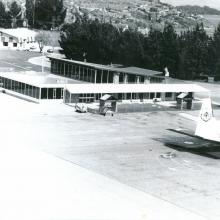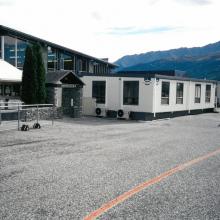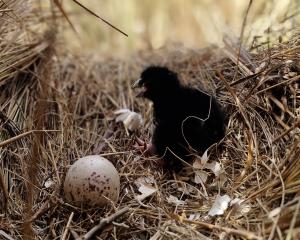
It was 1935 when the Civil Aviation Authority first gazetted Queenstown Airport, at that time as an aerodrome, but it was another 30-odd years before the airport really took flight.
Initially a grass landing strip with a couple of hangars — which remain today — it was only in the 1950s that aviators decided to take it seriously as an airport.
Highly respected airman Jules Tapper, who thought he had had a longer association with Queenstown Airport, as a pilot, than just about anyone else in New Zealand, believed the Mt Cook Group, which secured its licence to Queenstown in 1964, was the real catalyst for change.
"From there on, once there was an air service with [increasingly] larger aircraft coming on, things really started to move.
"Mt Cook and Air New Zealand were both marketing offshore and bringing in a lot of Australians and people from the United States."

Soon enough, however, the airport courted controversy.
Queenstown Lakes Mayor Jim Boult recalled that when Air NZ introduced the Boeing 737-200, a member of the public staged a protest.
"Somebody had gone out on the runway with a can of spray paint and painted on the runway ‘no Boeings’.
"So the airport went out with a can of black paint and covered it up, but you could still see the words there for some years."

The concern was about aircraft noise — at that stage, Mr Tapper said, the Boeings had to be fitted with hush kits to reduce the engine noise.
Almost 30 years on, that remains an issue in some sectors of the community.
Airport chief executive Colin Keel, appointed in 2016, had to grapple with the airport’s 30-year master plan and an uprising from some sectors of the community.
In part, the issue is about air noise boundaries — and a desire, pre-Covid-19, to increase them.
Initially the airport wanted to enable 41,600 flights to land in the resort by 2045, an average of 114 a day, but after an outcry from the community that plan was put on hold in 2018.
Last year, two Queenstown Airport Corporation (QAC) proposals were listed by the council — majority shareholder of the airport — on the Government’s electronic tender service system, looking for consultants to assess the social and economic effects of airport development.
One was to expand air noise boundaries to accommodate a maximum of 5.2million passenger movements and develop Wanaka Airport for domestic services initially, with capacity for international capable jet services in the future.
Two alternatives were distributing flights to Christchurch, Dunedin and Invercargill Airports with "little or no growth" at Queenstown or Wanaka Airports, and no growth at Queenstown Airport and development of commercial flights at Wanaka Airport.
Former Frankton Community Association president Glyn Lewers — now a district councillor — said the extent of the air noise boundaries, when they were revealed in 2018, came as a shock to Frankton residents.
"The overwhelming majority view in the community was, ‘it’s too much’ ... it was a bridge too far."

In the past five years the airport had had compound growth of about 15% year-on-year, he said, and the community had struggled.
"It was too fast, nothing was keeping up and it was just starting to get overwhelming.
"You coupled that with the cost living pressures, you could understand why this angst was just bubbling away and it just festered.
"In some respects I feel like the airport was the lightning rod for this outpouring of annoyance towards just normal living."
In some respects, Covid-19 had been a blessing, Cr Lewers said.




In the Frankton community it confirmed the airport’s importance to the economic vitality of Frankton and the Wakatipu, and reiterated its importance as an employer.
"I’m talking to pilots and cleaners and Customs officers ... it’s those sorts of people — they’re part of the community and the airport actually provides employment and work for us," he said.
The pandemic had also provided a "second chance" for the airport and the community to work together on future plans.
"I think we’ll get there in the end.
"Frankton was established in 1863, the airport’s 85 years old.
"Both ... have grown together ... and there’s nothing stopping us being good neighbours and actually driving together for another 85-odd years."
Mr Keel was determined the airport would survive Covid-19 and continue to serve the community from its present location.
Covid-19 had, however, changed the game.
In 2019, more than 2.3million passengers moved through the airport — in the 12 months to June this year there had been a 19% decrease, to 1.87million.
While some believed tourism peaked last year and we may never see those sorts of numbers again, Mr Keel said there was too much uncertainty at present to make a definitive call.

The industry was still unsure how much fleet capacity would come back into the system (aircraft manufacturers such as Boeing and Airbus report a 40% reduction in fleet capacity), what the cost of air travel would be and what the appetite for long-haul travel in future might be.
"It’s a long game at the moment," Mr Keel said.
"But given the fragility and the fluidity of the situation that we’re in, that could change and it could change on a dime.
"It’s fair to say some of the more challenging issues we’ve confronted over the last several years, related to the growth of the district ... have been moved down the road ... by some years."
Mr Tapper agreed.
The airport’s existing air noise boundaries had had "about two years of space" before they would reach capacity, before Covid-19, he said.
"We will never, in the next 10 to 15 years, see anywhere near the number of movements — even if Covid goes away."
Further, the advancements in aircraft technology — where planes had greater capacity, and significantly less engine noise — would play a major part.
"This airport here’s got a lot of capacity left in it and, with modern airplanes and the effects of Covid, we don’t have a problem here for at least another 20 years, I’d say."
Despite all the uncertainty of the last few months, Mr Keel also felt there were silver linings.
Primarily, it gave the community and the airport time to "really find what we want ... and not work at cross-purposes, but come together and work together on that".
"We’ve got a passionate and engaged community in this part of New Zealand, and I think that’s a terrific thing to have, but that cross-section of views need to be balanced ... and not extreme."
Comments
QAC is determined in refusing to see an end to growth, which is what the community is asking for. Growth economics is killing our planet and us, by extension, but it seems that many will have to suffer before the majority wake up to the problem.











